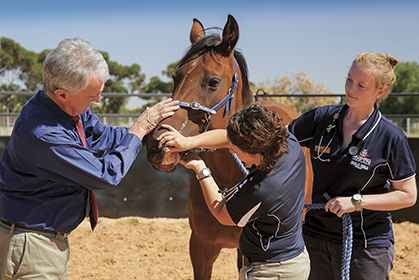All creatures great and small

Professor Wayne Hein with 6th year students Hannah Cohen and
Chelsea FowlerFor 130 years, South Australia grew rich thanks to what people learned at Roseworthy Agricultural College. Professor Wayne Hein is now charged with keeping the garden of knowledge growing at the state’s current home of vet science and animal husbandry, the University of Adelaide’s School of Animal and Veterinary Sciences.
If Professor Hein feels the pressure at the end of his first week on campus he does not show it, but he does acknowledge the heritage he must protect and the achievements he intends to extend.
As a boy originally from a Murray Bridge farm, who spent years growing up in the Barossa, where he has returned to live, Professor Hein is very conscious of what he is working with: “Roseworthy has a very long legacy,” he says. In the nineteenth century the agricultural community in South Australia was quick to recognise the need for education. Other Australian colonies followed its lead. In fact Roseworthy was one of the first agricultural colleges in the British Empire.
And the love of its lineage continues today. “Roseworthy has a very strong alumni. A lot of people are attached to it and expect it to expand.”
With two big, and newly combined jobs, Campus Dean and Head of the School of Animal and Veterinary Sciences, his is a task for a researcher and teacher, an entrepreneur and diplomat.
One primary set of challenges is campus focused.
“There is much more to Roseworthy than the University – it is also home to partner researchers, including a member of the federal government’s prestigious cooperative research programme, as well as a range of state research facilities in pigs and poultry, plus grain and animal science centres,” says Professor Hein.
In addition to the veterinary school, Roseworthy has 300 animal sciences students being educated to work on genetics and breeding of flocks and herds in commercial agriculture.
Hein also points to Roseworthy’s potential, “we have 4000 acres of good farmland, there is definitely scope to grow”.
But while he must ensure people who know and love the campus are comfortable now and optimistic about for the future he also has to ensure it appeals to others who think it is remote. Certainly it was once, but that was before people from nearby Gawler could commute the 50 kms to work in Adelaide. “50 kms – it’s a doddle,” Professor Hein says.
It is also important to remind communities in the north of the city that the campus offers convenient pet care. Veterinary science students learn by working with sick and diseased animals and while Roseworthy has easy access to farm stock, cats and dogs are needed. “Caseload is the currency of vet schools, the accreditation authority demands it,” Professor Hein says. “And it’s good for the community who can visit general and specialist vets with their animals as part of the leading program,” he says.
This makes it essential to build relationships with local vets so they know about Roseworthy’s specialist skills and complex resources – no suburban vet has a CT scanner that is big enough for a horse.
Roseworthy does, with an impressive piece of horse-sized kit arriving just weeks ago. This new state-of-the-art equipment means Roseworthy can provide South Australians in general, and vets in particular, with top quality diagnostic imaging so animals of all kinds and sizes can receive the most appropriate and highest quality clinical care.
“It also means we can provide our veterinary students with the most up-to-date education in diagnostic imaging, and provide a new research tool for our animal scientists,” Professor Hein says.
Professor Hein says he faces perceptions, as part of the new role, that are more apparent than real.
There is an argument in the profession that Australia has too many vets. Professor Hein is not so sure: “If there is a problem with jobs it might be in small animal practices in eastern state clinics.”
“Adelaide has a deliberate strategy to train for regional areas, our graduates have no trouble finding work,”he says.
Certainly young people think so. There are four applicants for every one of the 50 places in each year’s veterinary school intake and while academic entry scores are important, the University is very careful about whom it accepts, with an interview and written submission. “Many of our students come from farms and have an emotional attachment to animals,” Professor Hein adds.
But although there is demand, Professor Hein is happy with existing local enrolments, although he can see the school easily attracting more fee-paying students.
“The small-animal side is readily transferable and in terms of animal production systems there are vast parts of Africa and China with similar dryland agriculture.”
It’s a vision of service as old as Roseworthy itself, connecting South Australia to the wider world, in the service of ethical animal husbandry.
|





